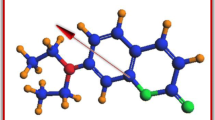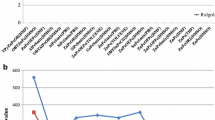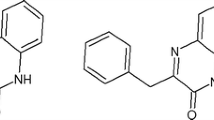Abstract
The photophysical properties of chlorin e6 (Ce6) in twelve different protic, aprotic and non-polar solvents were investigated using ultraviolet–visible and fluorescence spectroscopic methods. Solvatochromic effects were determined by the changes in quantum yield, Stokes shift, fluorescence half-life and excited state dipole moments of Ce6 in the different solvents. The absorption shifts observed in different solvents were further analyzed using the Kamlet-Abboud-Taft model and the nature of solute-solvent interactions between Ce6 and different protic and aprotic solvents was elucidated. The quantum yields were found highest in protic solvents (except water), followed by aprotic and non-polar solvents. Solvent polarity parameters showed a linear increasing trend with Stokes shift and fluorescence half-life, which indicated the presence of Ce6-solvent interaction. Using the Kamlet-Abboud-Taft model, a direct correlation between the solvent polarity parameters and absorption shift was observed, which substantiated the existence of Ce6-solvent interaction by hydrogen bond formation. The excited state dipole moments in specific protic and aprotic solvents were found to be higher than the ground state dipole moments, implying a more polar nature of Ce6 during excited state transition.






Similar content being viewed by others
References
Rauf MA, Graham JP, Bukallah SB, Al-Saedi MA (2009) Solvatochromic behavior on the absorption and fluorescence spectra of Rose Bengal dye in various solvents. Spectrochim Acta A Mol Biomol Spectrosc 72:133–137
Umadevi M, Suvitha A, Latha K, Rajkumar BJ, Ramakrishnan V (2007) Spectral investigations of preferential solvation and solute-solvent interactions of 1,4-dimethylamino anthraquinone in CH2Cl2/C2H5OH mixtures. Spectrochim Acta A Mol Biomol Spectrosc 67:910–915
McRae EG (1957) Theory of solvent effects on molecular electronic spectra. Frequency shifts. J Phys Chem 61:562–572
Beddard GS, West MA (1981) Fluorescent probes. Academic, London
Wehry L (1990) Effects of molecular environment on fluorescence and phosphorescence. In: Guilbault GG (ed) Practical fluorescence, 2nd edn. Dekker, New York
Jang B, Choi Y (2012) Photosensitizer-conjugated gold nanorods for enzyme-activatable fluorescence imaging and photodynamic therapy. Theranostics 2:190–197
Biswas S, Ahn HY, Bondar MV, Belfield KD (2012) Two-photon absorption enhancement of polymer-templated porphyrin-based J-aggregates. Langmuir 28:1515–1522
Reichardt C (2004) Solvents and solvent effect in organic chemistry, 3rd edn. WILEY-VCH Verlag GmbH & Co., Weinheim
Mannekutla JR, Mulimani BG, Inamdar SR (2007) Solvent effect on absorption and fluorescence spectra of coumarin laser dyes: evaluation of ground and excited state dipole moments. Spectrochim Acta A Mol Biomol Spectrosc 69:419–426
Gómez ML, Previtali CM, Montejano HA (2003) Photophysical properties of safranine O in protic solvents. Spectrochim Acta A Mol Biomol Spectrosc 60:2433–2439
Guo H, Jiang J, Shi Y, Wang Y, Dong S (2007) Solvent effects on spectrophotometric titrations and vibrational spectroscopy of 5,10,15-triphenyl-20-(4-hydroxyphenyl)porphyrin in aqueous DMF. Spectrochim Acta A Mol Biomol Spectrosc 67:166–171
Wang X, Lu M, Huo C, Li H, Wang Y, Li Z (2009) Solvent effects on the absorption, circular dichroism and Raman spectroscopy of meso-tetrakis [3-methoxy-4-(N-carbazyl)n-hexyloxyphenyl] porphyrin in water-THF solution. Spectrochim Acta A Mol Biomol Spectrosc 73:581–586
Gonçalves PJ, Franzen PL, Correa DS, Almeida LM, Takara M, Ito AS, Zílio SC, Borissevitch IE (2011) Effects of environment on the photophysical characteristics of mesotetrakis methylpyridiniumyl porphyrin (TMPyP). Spectrochim Acta A Mol Biomol Spectrosc 79:1532–1539
Jeong H, Huh M, Lee SJ, Koo H, Kwon IC, Jeong SY, Kim K (2011) Photosensitizer-conjugated human serum albumin nanoparticles for effective photodynamic therapy. Theranostics 6:230–239
Mataga N, Kubota T (1970) Molecular interactions and electronic spectra. Dekker, New York
Kawski A (1966) der Wellenzahl von elecktronenbanden lumineszierenden moleküle. Acta Phys Polon 29:507–518
Dabrowski JM, Pereira MM, Arnaut LG, Monteiro CJ, Peixoto AF, Karocki A, Urbańska K, Stochel G (2007) Synthesis, photophysical studies and anticancer activity of a new halogenated water-soluble porphyrin. Photochem Photobiol 83:897–903
Nagy PI, Völgyi G, Takács-Novák K (2008) Monte Carlo structure simulations for aqueous 1,4-dioxane solutions. J Phys Chem B 112:2085–2094
Allen BD, Benniston AC, Harriman A, Rostron SA, Yu C (2005) The photophysical properties of a julolidene-based molecular rotor. Phys Chem Chem Phys 7:3035–3040
Vladimir S, Victor A, Igor V, Tjeerd J, Holten D (2000) Comparative study of the photophysical properties of nonplanar tetraphenylporphyrin and octaethylporphyrin diacids. J Phys Chem B 104:9909–9917
Duerr K, Troeppner O, Olah J, Li J, Zahl A, Drewello T, Jux N, Harvey JN, Ivanović-Burmazović I (2012) Solution behavior of iron(III) and iron(II) porphyrins in DMSO and reaction with superoxide. Effect of neighboring positive charge on thermodynamics, kinetics and nature of iron-(su)peroxo product. Dalton Trans 41:546–557
Maiti NC, Mazumdar S, Periasamy N (1998) J- and H-aggregates of porphyrin − surfactant complexes: time-resolved fluorescence and other spectroscopic studies. J Phys Chem B 102:1528–1538
Melavanki RM, Patil HD, Umapathy S, Kadadevarmath JS (2012) Solvatochromic effect on the photophysical properties of two coumarins. J Fluoresc 22:137–144
Weitman H, Schatz S, Gottlieb HE, Kobayashi N, Ehrenberg B (2001) Spectroscopic probing of the acid–base properties and photosensitization of a fluorinated phthalocyanine in organic solutions and liposomes. Photochem Photobiol 73:473–481
Acknowledgments
This research is supported by the Singapore Ministry of Health’s National Medical Research Council under IRG NMRC/1187/2008 (R-148-000-114-213) and GEA-NUS PPRL fund (N-148-000-008-001). There is no conflict of interest.
Author information
Authors and Affiliations
Corresponding author
Rights and permissions
About this article
Cite this article
Paul, S., Heng, P.W.S. & Chan, L.W. Optimization in Solvent Selection for Chlorin e6 in Photodynamic Therapy. J Fluoresc 23, 283–291 (2013). https://doi.org/10.1007/s10895-012-1146-x
Received:
Accepted:
Published:
Issue Date:
DOI: https://doi.org/10.1007/s10895-012-1146-x




